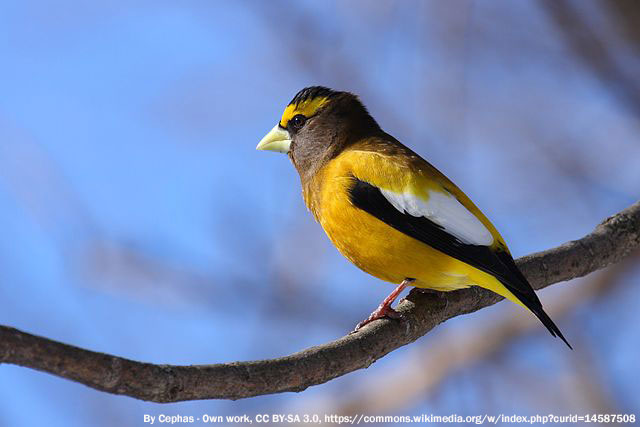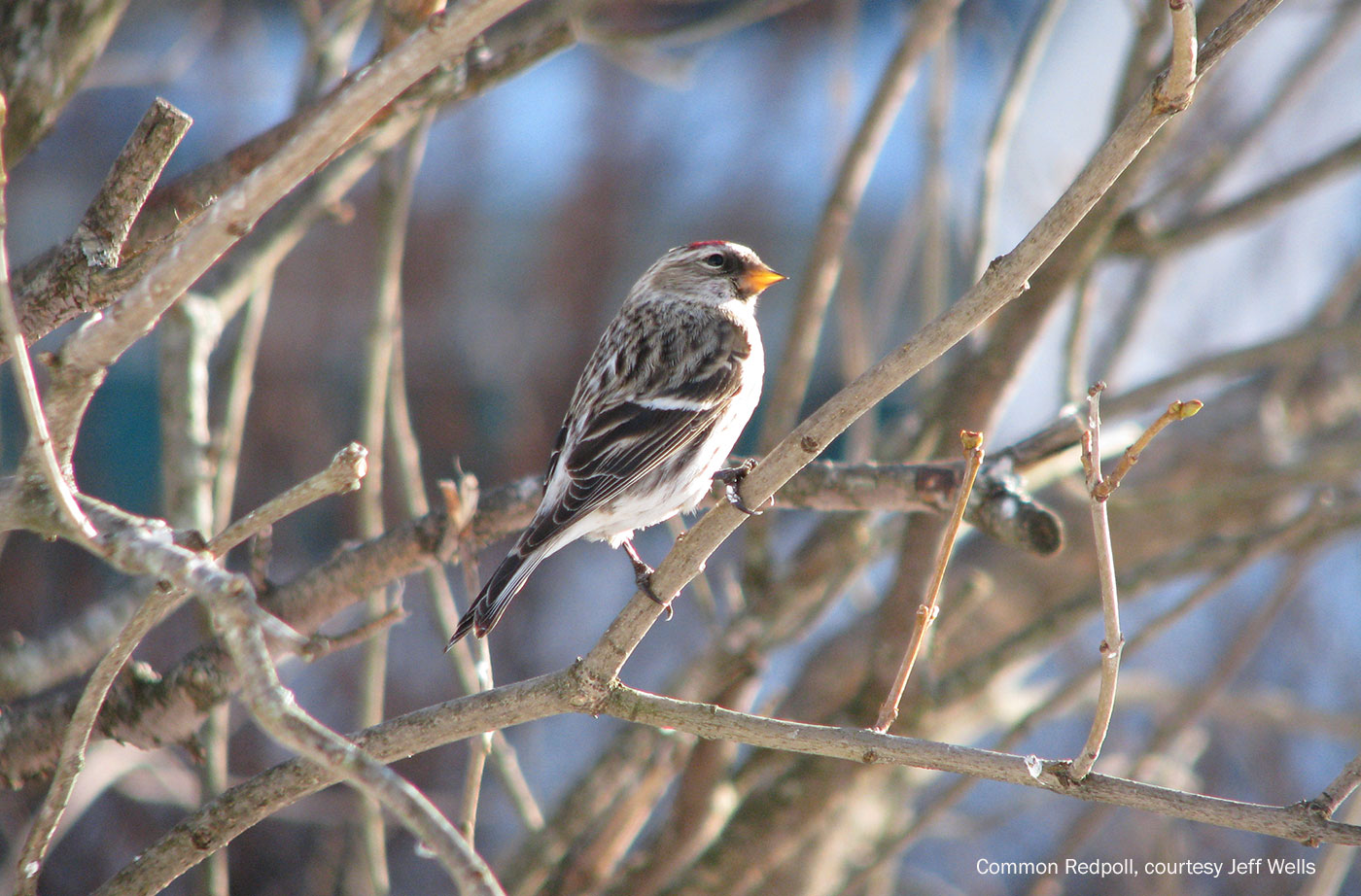For birders, especially those of us here in Maine and the eastern U.S., a holiday of sorts is fast approaching. Bird enthusiasts anticipate it the way many youngsters look forward to Christmas morning. But this fine-feathered special occasion takes place just once every two years or so. Staffers at the Natural Resources Council of Maine have experienced it right outside the office windows.
We are referring to the so-called winter finch “irruptions” or “invasions,” which originate largely from the Boreal Forest region of Canada and Alaska and move southward as the season progresses. By “winter finches” we mean those finch species that are not typically found in these parts outside of irruption years: Pine Siskin, Common Redpoll, Hoary Redpoll, Evening Grosbeak, Pine Grosbeak, and sometimes White-winged Crossbill. Except for the two redpoll species, all of these birds have a vast range across Canada and (except for Evening Grosbeak) Alaska, but reach the southern limit of their regular breeding distribution in Maine, New Hampshire, and Vermont. All but Pine Grosbeak (which will consume fruits and berries) are almost exclusively seed eaters.
That of course makes them ideal candidates to show up at your winter bird feeding station. At our feeders in Gardiner, we have already had as many as six Pine Siskins enjoying our offering of thistle seed. Indeed, siskins seem to have had an early push southward across most of the eastern U.S., with individuals spotted as far south as the panhandle of Florida, and one was found way out on Bermuda in October!

Evening Grosbeak
Evening Grosbeaks, a winter finch favorite, have been reported for the last several weeks. We haven’t been among the lucky ones to have seen Evening Grosbeaks in our yard—yet! But many Maine birders have, and Mainers aren’t the only ones seeing them. This year Evening Grosbeaks have already been reported as far south as Virginia. Some of us remember the massive flocks of hundreds of Evening Grosbeaks that were regular winter visitors in Maine as late as the 1970s and early 1980s.
With this being the Year of the Bird, it is a good time to consider that Evening Grosbeaks have since experienced a steep decline—a more than 80 percent drop in abundance since those times. Researchers attribute this fall off possibly to development activities such as logging in the Boreal Forest region. Disease outbreaks (salmonella, West Nile, etc.) also could be a factor. Some data implicates the drop in spruce budworm and other insects that are impacted by aerial spraying. Perhaps the biggest threat to Evening Grosbeaks is climate change; climate models suggest that balsam fir will be lost from the northern U.S. landscapes, which would mean Evening Grosbeaks could disappear forever from Maine.
Pine Grosbeaks nest largely in the northern half of the Boreal Forest of Canada and Alaska, occasionally breeding south in to Maine and the Maritimes. Common Redpolls are more northerly; their breeding range encompasses the northern Boreal Forest region northward into the Arctic.
Common Redpolls are similar in size and shape to Pine Siskins but are much whiter with a red patch on the front of the head and a yellow bill. They have begun arriving in Maine with a handful of reports over the last few weeks. And like the other wanderers, sightings have come from farther south—as far south as Cape May, New Jersey.

Common Redpoll
One of our favorites among the winter finches are the Pine Grosbeaks, with their propensity for feeding in crab apple trees. They often exhibit very tame and confiding behavior. Add to that their mellow and sweet calls and you can understand why we enjoy them so much. We just heard a few days ago of the first report of these birds in the state, but the Cornell Lab of Ornithology’s eBird database shows lots of them just to our north in southern Quebec. We will be watching and listening closely for them—including out the windows of NRCM headquarters, where flocks of Pine Grosbeaks have in the past descended upon the fruit trees nearby, delighting all who watched them!
As we eagerly track this birder’s “holiday” that is the winter finch invasion, we join with millions of birders from across the U.S. and Canada to celebrate the Year of the Bird that commemorates the historic treaty and legislation that came to pass a hundred years ago. It has been crucial to maintaining healthy populations of these and all of our migratory birds—the Migratory Bird Treaty and the U.S. Migratory Bird Treaty Act. Without it, we would likely have far fewer birds to celebrate.
The year 2018 marked the 100-year anniversary of the signing of the Migratory Bird Treaty Act (MBTA). It’s because of this treaty that many bird species—including some for which Maine is well known—are still with us rather than disappearing from the earth forever. In honor of this anniversary, the Natural Resources Council of Maine, along with a large coalition of other groups including the National Geographic Society, Birdlife International, the National Audubon Society, the Cornell Lab of Ornithology, and others declared 2018 to be the Year of the Bird. In celebration of this conservation success story, and to put the spotlight on the importance of initiatives such as these, birders Jeff and Allison Wells posted each month in 2018, the “Year of the Bird.”










We had 5 (rarely seen) pine siskin at our feeder (Newtown Square, PA) last week. I’m watching closely for the Redpoll and Grosbeak. I’d love a visit from them.
Thank you for your comment, Marilyn. Congrats on the siskins- I bet you’ll see more species soon, especially if you are watching for them! Jeff saw an Evening Grosbeak in our yard – right after I left to take our son to school!
Good birding,
Allison
We had 3 Evening Grosbeaks at our feeder this morning in Owls Head ME!!